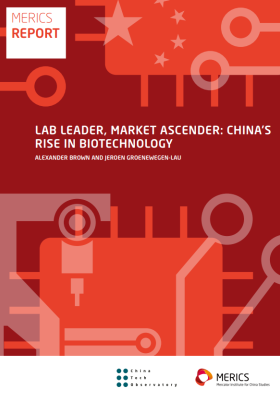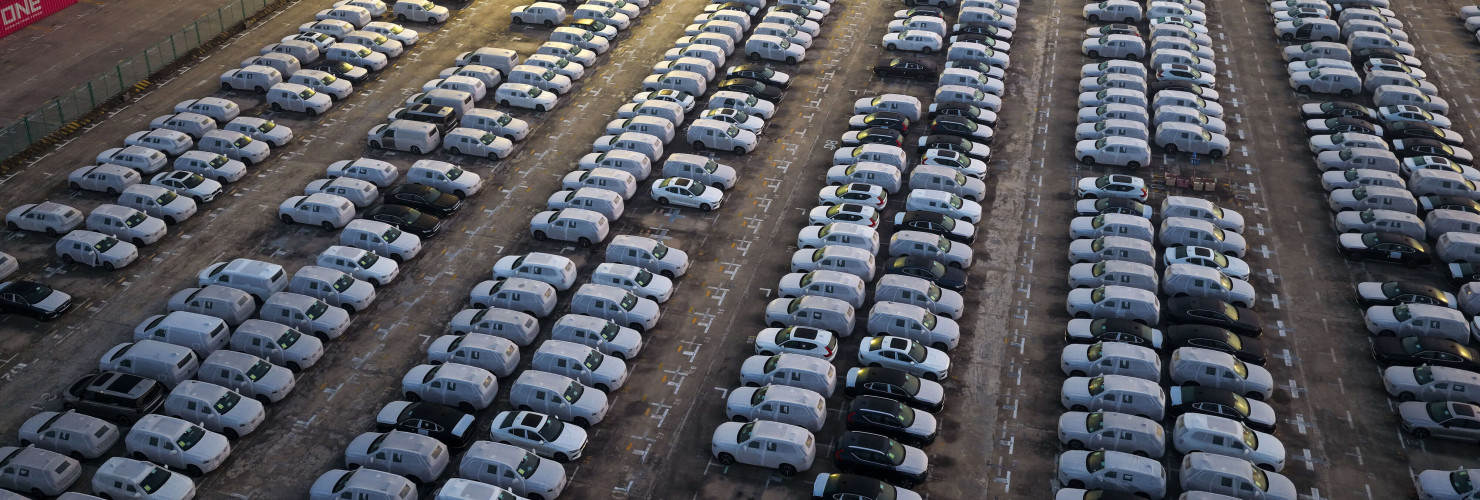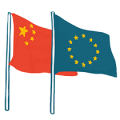

EV tariffs + EU-China policy at an inflection point + Exports to China
Analysis
One year on from EU’s EV tariffs: Results and strategic choices ahead
By Jacob Gunter and Grzegorz Stec
The EU is currently evaluating the effectiveness of its tariffs on Chinese-made electric vehicles (EVs) since their introduction a year ago. The countervailing tariffs of 17 to 35.3 percent, which were based on investigations into several EV makers in China by the Commission, came on top of the EU’s standard ten percent car import duty. Just how the EU measures the tariffs’ effectiveness depends on their intended purpose. Were they meant only to address price distortions from subsidies or to decrease or even stop the flow of EVs from China? Or were they meant to drive Chinese automakers to invest in production sites in the EU – or a combination of all of those?
The tariffs have had mixed results
If measuring the impact on price distortions, the result is mixed but leans positive. The Commission’s investigation was exhaustive and certainly enabled it to set tariffs measured to offset the subsidies China-based EV makers have enjoyed. However, they were based on specific support measures and could not take into account the price wars driven by overcapacity which have shaped EV-makers’ strategy to accept razor thin margins – and even losses. Their willingness to accept margins in export markets that are very low but still higher than those in China has created global price distortions.
If measuring effectiveness by stemming or even stopping the flow of China-made EVs (which is not a stated goal, but which some observers use as a metric of success), the result is a profound failure. Chinese EV brands doubled their market share in the EU in the last year, in part by quadrupling exports of plug-in hybrids (PHEVs) which circumvent the tariffs. That is happening even as European car exports to China continue to decline.
If measuring effectiveness by Chinese investments in EU production sites to avoid tariffs, the situation is difficult to judge. Chinese EV makers have announced several planned investments and production lines in the EU since the tariffs: BYD is modestly expanding an electric bus plant in Hungary, XPENG is licensing production of several models in Austria, and Chery invested in a large research and development (R&D) center attached to its existing investment in Spain.
However, it is difficult to determine the weight of the tariffs on those corporate decisions. Chinese EV makers that may have been considering investments in the EU may also have been deterred by Beijing’s order in fall 2024 to pause investments in member states that supported the EV tariffs. They may have interpreted it as Beijing discouraging investments generally in Europe. Now that Beijing knows EU member states’ would like more Chinese EV investments, China may allow or even encourage its EV makers to invest in those ”friendlier” member states.
China-made EVs will continue to expand in the EU market
China is expected to significantly increase its total car production and exports in the coming years. The China Passenger Car Association (CPCA) announced in September that it expects China to export as many as 10 million cars by 2030. Not all of those will be bound for the EU, but there are hard limits as to where sufficient numbers of customers can be found, especially as a market needs enough consumers who can afford such cars in the first place.
- The US holds little hope for China’s EV makers, who correctly anticipated both former President Joe Biden’s and Donald Trump’s measures on Chinese EVs.
- Japan and South Korea lack restrictions, but their consumers overwhelmingly prefer local brands over foreign ones, Chinese or otherwise.
- Many BRICS members have raised barriers on Chinese cars, including Russia through new “recycling” fees, and India which is set to only permit imports once companies have invested enough in the market.
China’s automotive industry has seen fixed-asset investments increase by over 20 percent year on year in every month of 2025 so far, and much of that new capacity will need to be exported. Middle income and poor countries will be able to absorb a large share of China’s surging car exports, but the EU will be the preferred market. Its large middle class means a higher share of households can afford Chinese cars, and those can be sold at higher margins than elsewhere. China will fight hard to maintain access to the EU market for its cars, as losing it means losing a critical pressure valve for its overcapacity problem.
What can Europe do?
The EU has been exploring three broad avenues of how to deal with the challenge:
First is negotiating price floors, or even quotas – either EU import quotas or China’s voluntary export limits – to mitigate excessive uneven competition. The European Commission attempted a negotiated solution, but consultations with China since June 2024 have not been fruitful. Beijing wants sector-wide price floors while Brussels is arguing for a company-specific approach.
Second is using such measures as state-aid conditionality, the foreign subsidies regulation (FSR) and procurement criteria to introduce a preference for local content or joint venture and technology-transfer requirements so Chinese investments in Europe create jobs and build up the capabilities of European companies. This aligns with the broader discussion within the EU to support the development of European industries, for instance through:
- The Clean Industrial Deal State Aid Framework, which enables member states to condition access to clean tech subsidies;
- Mandatory non-price procurement criteria proposed under the Net-Zero Industry Act;
- Signals that foreign subsidies regulations could apply to investments like BYD’s in Hungary.
Third, and most politically contentious, are potential restrictions on the use of Chinese EVs – and in the future, autonomous vehicles – on security, data, and privacy grounds. This could result in outright bans or local sourcing of the risk-related hardware/software. For instance, the Automotive Industry Action Plan foresees conducting a dedicated risk assessment of connected vehicles.
The final outcome will likely be a mix of these approaches. They could be mixed with a more strategic and coordinated deployment of other trade defense instruments and de-risking tools, which Brussels seeks to achieve by currently consolidating its Economic Security Doctrine.
The EU and its member states will need to remain committed, as Beijing will respond along the way. For instance, China attempted to pressure Europe into concessions on EVs ahead of the EU-China summit by limiting access to rare-earths exports essential to multiple European sectors. This highlights the importance of access to European automotive markets for China. Beijing is also gearing up to respond to the EU’s ambitions to ensure tech transfer by imposing export licensing measures on China’s most advanced automotive technologies, like batteries and light detection and ranging (LIDAR) systems.
How Europe navigates the EV issue and whether it manages to build resilience and maintain credibility vis-à-vis Beijing will indicate how economic competition is handled in other sectors.
Read more:
- MERICS: Beyond overcapacity: Chinese-style modernization and the clash of economic models
- MERICS: Series on China's rare-earths export controls
- MERICS: Europe needs swift action in regulating data-gathering smart cars
- SCMP: Car trade in reverse as Germany’s deficit with China jumps 143%
- Reuters: China to require EV export permits to safeguard Chinese brand image overseas
Update
EU’s China policy is at an inflection point
Brussels seems to be acknowledging that attempts at rapprochement with Beijing, sparked by Donald Trump’s efforts to upend global trade, have yielded few results. After the July EU-China summit, European Commission President Ursula von der Leyen described the moment as a “clear inflection point” in bilateral relations. As the tensions continue, Brussels appears to be mulling an adjustment to its China policy approach.
What you need to know:
- Taking stock: The summit, which was meant to be a litmus test for addressing challenges in EU-China relations under the new geopolitical reality, failed to deliver. It produced two outcomes: a vague joint statement on continuing efforts to combat climate change and a new alert system to manage supply disruptions for EU businesses caused by China’s strict export licensing system for rare earths, a key concern for the EU.
- Tensions continue: But the mechanism seems to have had little impact so far. As of mid-September, the EU Chamber of Commerce in China indicated that less than a quarter of the more than 140 rare earths export license applications it monitors had been approved so far. China’s new additions on October 9 of five new rare-earth elements and of refining technology to the export controls lists and the requirement of compliance by foreign rare-earths producers signal that Beijing will likely intensify the use of this leverage. Separately, in early September, China placed initial anti-dumping duties of up to 62.4 percent on pork imports from the EU, just after extending its anti-subsidy investigation into European dairy to February 2026. The measures are set to further exacerbate the issue of growing trade imbalances and trade diversion.
- Brussels is mulling an assertive turn: Against this backdrop, high-ranking EU officials signaled growing interest in building up the EU’s capacity to deter such economic coercion, as engagement with China on this failed to resolve the EU’s concerns. The Commission is reportedly building a list of chokepoints it could leverage and mulling new anti-dumping investigations that target China. It also responded to an increase of Chinese steel exports by doubling tariffs on foreign steel and halving the volume allowed in before duties apply. The EU’s Economic Security Doctrine, which aims to make more strategic and coordinated use of its economic security and trade defense tools, could bring a meaningful shift when it is adopted in the coming months.
- Russia angle: The EU also remains concerned by China’s role as an enabler of Russian aggression, planning to include 12 Chinese entities in the upcoming nineteenth package of Russia sanctions. Beijing will likely view the move through the prism of Washington’s push for the EU to target China and India in its shifting effort to end the war in Ukraine.
Quick take:
Brussels is expanding the list of options for putting pressure on China and pursuing a more active policy. The key challenge will be sustaining commitment to the assertive line. Especially as Beijing believes, despite domestic economic headwinds, that it can withstand more pressure than EU governments, which are more vulnerable to market shocks and public discontent. To build up deterrence, the EU will need to follow through on major measures it signals.
Read more:
EUROPE-CHINA DIPLOMATIC TRACKER
- The EU-China summit in July highlighted persistent strains in bilateral relations, with European Commission President Ursula von der Leyen calling the moment an “inflection point.” Despite tensions, Brussels remains intent on keeping communication with Beijing open, particularly on climate and multilateral cooperation, as Washington’s commitment wanes or even turns hostile. This was reflected in the amicable language of the meeting readout between von der Leyen and China’s Premier Li Qiang on the sidelines of the United Nations General Assembly in September, contrasted with Donald Trump’s combative speech.
- The thaw between the European Parliament and China continues. On October 16, the EP is set to welcome its first delegation from the National People’s Congress in seven years. The move is part of unfreezing relations that have been on hold after Beijing’s escalatory sanctions targeting – among others – five MEPs and the Subcommittee on Human Rights. Through exchanges with EP President Roberta Metsola’s office, Beijing communicated its decision to remove sanctions on sitting MEPs at the end of April. An EP delegation is scheduled to travel to China in May next year.
- Foreign Minister Wang Yi travelled to Europe three times in the past three months, visiting Belgium, Germany, and France in July, Austria, Slovenia, and Poland in September and Italy and Switzerland in October. Despite the flurry of activity, the trips have not brought major outcomes. The first, which included the High-Level Strategic Dialogue, mainly prepared for the July EU-China summit and Chancellor Merz’s still pending visit to China. The second appeared aimed at countering Taiwan’s diplomatic outreach during Foreign Minister Lin Chia-lung’s visits to the Czech Republic, Italy, and Austria (September 11 to 20) and Poland (September 28-29). The visit to Italy will feature a review of the progress on the Action Plan to Strengthen the China-Italy Global Strategic Partnership signed in July 2024 and comes on the heels of discussions on handling Sinochem’s investment in Italian tyre making giant Pirelli.
- The High-level Strategic Dialogue, the first extended in-person meeting of the EU’s High Representative for Foreign Affairs Kaja Kallas and Foreign Minister Wang Yi, faced controversy over the media leak (confirmed by several sources) of Wang Yi’s statement to Kallas that China doesn’t want or even cannot afford for Russia to lose the war in Ukraine because it worries the US will shift its focus more on China. This could put a strain on this channel of communication between Brussels and Beijing in the future.
- Liu Haixing, a career diplomat with extensive background in European – particularly French – affairs, became the new head of the International Liaison Department responsible for the Chinese Communist Party’s diplomatic relations. Liu previously served in the rank of minister-counsellor in the Embassy in Paris. His appointment may increase the priority of engagement with European parties.
Soapbox-MERICS Data Highlight
 | The Soapbox-MERICS Data Highlight offers data visualizations of EU-China economic relations. We have partnered with trade specialist Rafael Jimenez Buendía, Lecturer of International Trade at Taltech University in Tallinn, Estonia, and co-founder of “Soapbox,” a free weekly newsletter focused on China trade. In this edition, Rafael zooms in on European exports to China and the US: |
High hopes have given way to modest results for EU exports to China since Xi Jinping came into office. From 2013 to 2025, EU exports to China grew at a 3.5 percent compound annual rate, versus 7.8 percent to the US. Post-COVID (2021–2025), China-bound exports fell three percent a year, while US-bound exports rose 12 percent.
The shortfall is broader than for automobiles: excluding autos, EU exports to China rose only 2.5 percent annually, signaling structural headwinds, including Chinese policies that privilege the domestic market over imports and prioritize a trade surplus.
Set against the US, the comparison is pragmatic. Turbulence around Donald Trump is hard to ignore, yet for EU firms, the US remains the more compatible partner: more transparent regulation, stronger IP enforcement, deeper capital markets, and closer standards alignment reduce risk and support scale.
This is the thorn in the European Commission’s side: market reality tilts transatlantic while balancing with China continues to be a challenge. How that tension is managed will shape the EU’s relevance and the credibility of its claim to strategic autonomy.
Short takes
China’s trade diversion hits Europe – textiles edition
In an example of how US tariffs seem set to further boost the EU-China trade imbalance, EU imports of Chinese clothing and textiles grew by 20 percent in value and volume in the first half of the year.
G7 considers price floors for rare earths
The move builds on the Critical Minerals Action Plan agreed by the G7 in June. The price floors proposal, which has not been formalized, could help alleviate the concerns of non-Chinese producers that they would be squeezed out of the market if Beijing intensifies its subsidies push. Beijing may be keen to maintain China’s leverage in the critical sector.
- Reuters: G7 weighs price floors for rare earths to counter China's dominance, sources say
- MERICS: Series on China's rare-earths export controls
Beijing limits use of Ericsson and Nokia in national telecom networks
While no formal ban has been issued, the European companies need to go through untransparent national security reviews by the Cyberspace Administration of China which can last several months. This puts them at disadvantage compared to Chinese competitors. Estimates indicate that the combined market share of the two companies dropped from 12 percent in 2020 to about four percent last year.
One of Europe’s lead battery scientists relocates to China
In an example of a wider competition for talent, Nanjing Normal University welcomed the world-leading battery scientist Stefano Passerini, who relocated there from Germany. China attracts scientists with considerable funding, offering extensive research opportunities and financial compensation.
New Lithuanian government plans restoring ties with China
The administration’s draft program signaled plans to “restore diplomatic relations with China to the same diplomatic level as in other European Union countries.” However, there are no plans to change the name of the “Taiwanese Representative Office” opened in 2021, and incoming foreign minister Kęstutis Budrys signaled plans to amend the program to restore some of the language on China, describing it as “contributing to the emerging threats.”
LRT: Lithuania’s government program pledges defence boost, tax stability and reset with China


